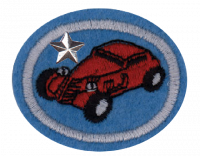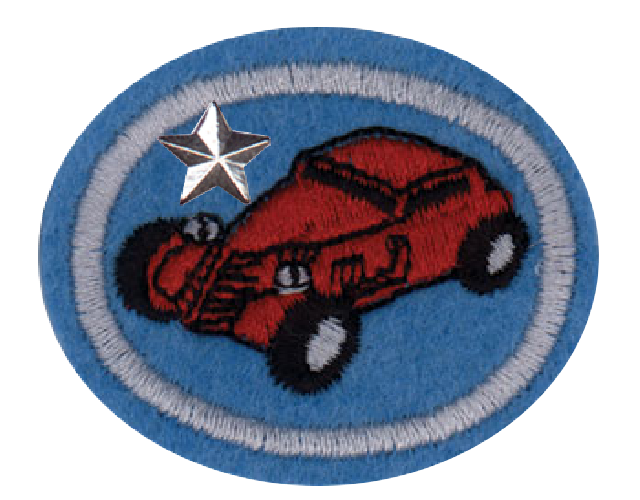AY Honors/Pinewood Derby - Advanced/Answer Key
Skill Level
2
Year
1999
Version
26.12.2024
Approval authority
General Conference
1
For tips and instruction see Pinewood Derby.
2
NOTE: Many conferences have special Pinewood Derby events and the rules may vary as to length, weight and wheels.
Contact your conference leadership for a copy of the rules. They usually email them out well ahead of the derby.
3
3a
In most Pinecar derbies, the axles must be inserted into the axle grooves that have been pre-milled into the bottom of the car.
3b
Sometimes cars come off the track. It is best of all the pieces remain with the car if this happens.
3c
Usually the registering official will affix the number. Often, they will do this on the bottom toward the front of the car so that the person placing the car on the track will know which end is the front.
4
The main safety rule to follow with any tool is to use common sense.
Coping saw
- Clamp your work firmly to a bench before cutting it with a coping saw. You may wish to pad the clamp with a piece of scrap wood so it does not mar the piece.
- Be careful not to saw into the bench.
- Keep your fingers clear of the blade.
Rasp
- Do not draw the rasp across your skin - it will cut skin even easier than it will cut wood.
- Do not strike a rasp with a hammer or mallet or it may shatter.
Plane
- Do not test the sharpness of a plane's blade by sliding it along a finger.
- Retract the plane blade when storing.
- Keep the blade sharp.
Knife
- Do not push the knife toward another person (or yourself!) when cutting. Imagine the path blade will follow if the item you are cutting suddenly give way, freeing the blade. Always make sure nothing is in that path.
- If you drop a knife, let it fall. Do not try to catch it.
- When handing a knife to another person, offer them the handle - not the blade.
- Do not throw the knife.
- Do not use a locking knife unless the blade is locked.
- For non-locking knives that fold, be aware that it may close on your hand if you apply pressure the wrong way.
- Do not pry with a knife - you may break the blade and cause a piece to go flying.
- Keep the blade sharp. Dull blades are dangerous.
Chisel
- Store the chisel with the blade covered.
- Keep the blade sharp.
- Keep both hands behind the blade.
- Use a mallet with the chisel rather than pushing it along with your hand. This will ensure that your hands are both behind the blade.
- Do not put a chisel in your pocket.
Sanding block
- Do not throw a sanding block
- Pay attention to the path of the sanding block. It is easy to knock something over when you're paying attention to the piece you're sanding instead of the surrounding environment.
- Do not sand skin. Sand paper will abrade skin.
5
5a
Wood should be sanded with successively higher grit paper. Start with 80 to 100 grit, and then move on to 150 or 220. Final sanding can be done with 320 grit paper.
5b
Holes can be filled with wood putty, though it is better to be careful when shaping the wood to not cause unintended holes. Simply press the putty into the hole and wipe it off with a putty knife or other hard, flat tool. Allow it to set before sanding, but do sand it before applying any other finish.
5c
New wood can be sealed with a grain filler. This is especially important on end-grain, as without a grain filler, the wood will absorb a finish more in this area giving the car an uneven look. It is applied with a brush and then wiped off and allowed to dry. Skip this step if you intend to stain the wood afterwards, as it will not absorb stain evenly.
5d
Wood can be colored by applying a stain, dye or a paint.
5e
A gloss finish will make the finished wood look very shiny. Most paints can be bought with a flat, satin, or glossy finish. If you want a shiny finish, choose a glossy paint.
5f
Enamel is a very tough and glossy finish. It is ideal for pinewood car designs modeled after real cars.
5g
Stain will color the wood but allow the natural grain to show. In other words, the wood will still look like wood, but it will be a darker colored wood.
5h
A wax finish is applied after the wood is stained and varnished. It brings a final polish out of the wood.
5i
Acrylic finish is a type of varnish. For the most part, it dries clear (but may impart a yellowish tint to the wood). It will lend a glossy look to the finished wood.
5j
Water colors will soak into the wood and can result in an uneven finish. The wood grain will show through, so unless that is what you are looking for, don't confuse it with other types of paint. It's best to try it on a scrap before painting your car with it. Then if you like what you see, go ahead and paint the car with it.
5k
A leather look on wood can be achieved by applying two colors of a water-based paint as well as a polyacrylic clear coat. These are the steps:
- Dampen the surface of the wood to raise the grain of the wood and let it dry for half an hour.
- Sand with 180 grit sandpaper.
- Paint with the first color of water-based paint. Apply two coats if desired.
- When the paint is dry, apply a layer of polyacrylic gloss clear coat. This is to keep the next color of paint from blending with the previous color.
- When the clear coat is dry, apply a coat of the second color using a water-based paint.
- After a few minutes, blot this coat with a plastic bag to reveal the color beneath in places.
- After the paint dries, lightly sand with 320 grit paper.
- Apply a second layer of the polyacrylic clear coat.
5l
See the Découpage honor for detailed instruction.
5m
Crumple a sheet of aluminum foil without wadding it into a ball (or it will tear). Flatten the foil out again and smooth it with a rolling pin. Apply tacky glue to your car, and then press the foil into the glue, shiny side up. Press the foil into all the crevices of the car. For an antique look, paint over the foil with a black, water-based paint which has been thinned 2:1 with water. Blot the paint with a paper towel.
6
7
7a
This is probably the most effective step you can take to make a car faster. Start by polishing the axles. This can be done by mounting the axle in the chuck of a drill, holding a piece of sandpaper (320 or higher grit) on the part of the axle that comes into contact with the wheel, and then spinning the drill. Do this to each axle as your patience endures.
When the wheel is placed on the axle and the axle is inserted into the car, apply some graphite lubricant into the wheel's hub and spin the wheel. Once assembled, it's a good idea to spin each wheel for as long as you have the patience. This works the graphite into the joint and lubricates it. You can spin the wheels by hand, or rig up a device of your own invention do do it for you.
7b
Aerodynamics plays very little role in the speed of a pinewood car. At this scale, the car just doesn't have enough surface area for aerodynamics to be a significant factor in the physics of a rolling car.
7c
A smooth finish has even less to do with a pinecar's speed than aerodynamics.
7d
If the bottom of a pinecar contacts the track, it will exert a tremendous amount of drag on the car. It might not even make it down the track if this happens. The most common way that a car will come into contact with the track is if weights are added to the underside of the car without countersinking them. Always countersink your weights so that you know the car will not drag on the track.
The axle should be inserted into the car such that it does not pinch the wheel against the car, but without much room for the wheel to slide back and forth on the axle. Ideally it should slide about a sixteenth of an inch.
7e
Wheel shaking occurs when the mold mark on the wheel's tread comes into contact with the track. This will happen once per rotation and will cause the wheel to jump into the air (even if ever so slightly). This energy would be put to better use powering your car toward the finish line. To address this issue, place the wheel into the chuck of an electric drill and rotate it against a piece of sandpaper you have mounted on a flat surface. Sand the tread down until it is smooth.
8
9
9a
9b
9c
10
11
Note: If you are planning to participate in a conference Pinewood Derby event be sure you use the correct specifications from your conference because some use different specifications than listed above.
12
While building and racing a pinewood derby car your Christian walk may be tested. If someone needed help on their design, did you help? If you are having trouble cutting your own car, did you accept help? Did you clean up your work area so the next person had a clean place to work, or so the staff didn’t have to clean up after you? Did you have to wait a while to use some of the tools? Being patient isn’t always easy.
Jesus was a Carpenter. Jesus may have spent many hours in a wood shop. I wonder if He helped Joseph design, transfer the design, clamp the wood, cut the wood with a saw, file, sand smooth, paint, assemble. I wonder how many tools did Jesus know how to use, that you just used yourself? I wonder...


